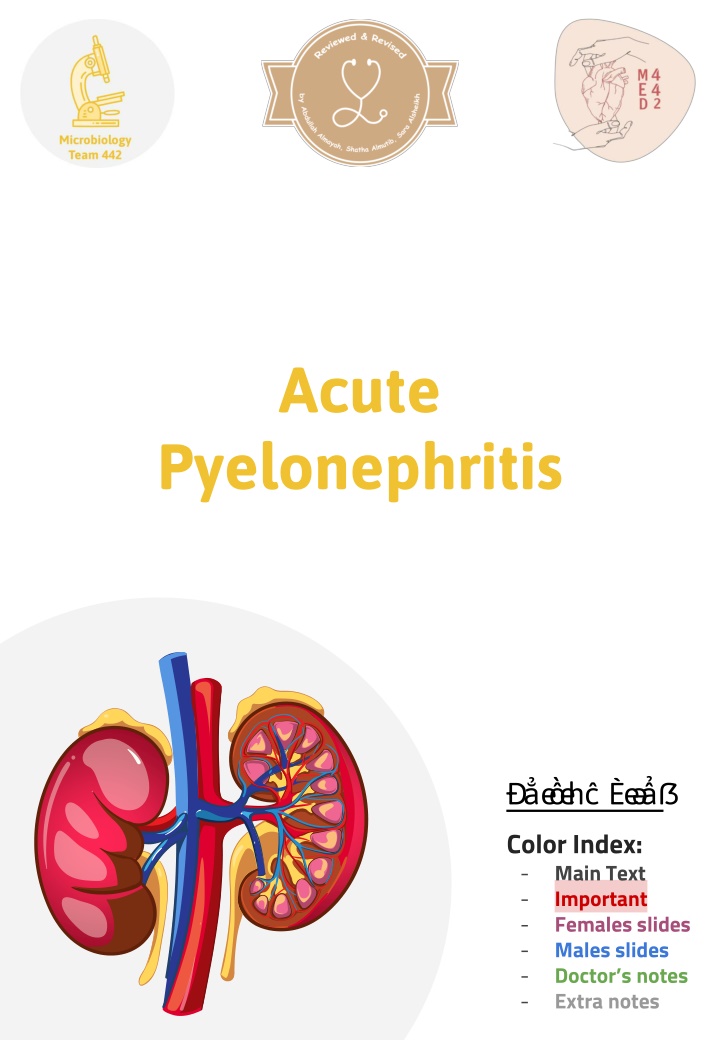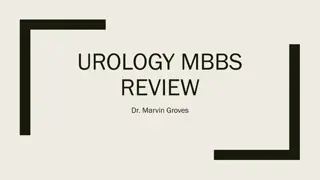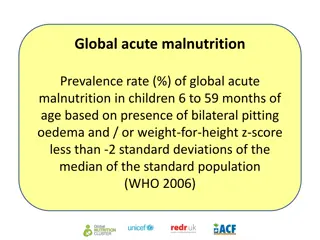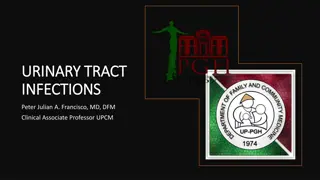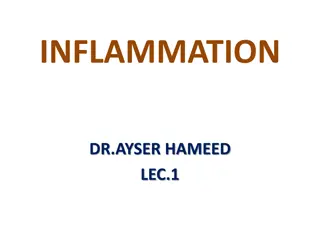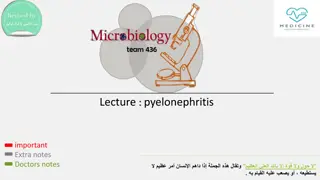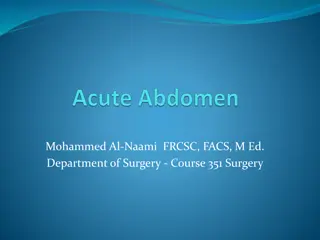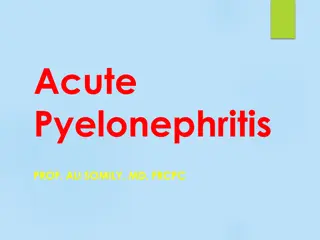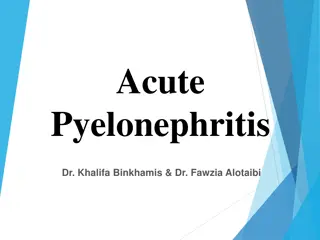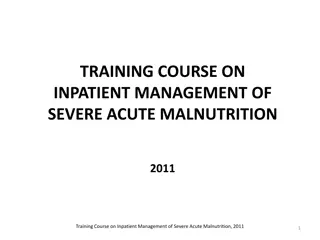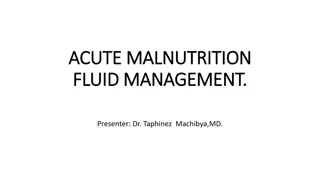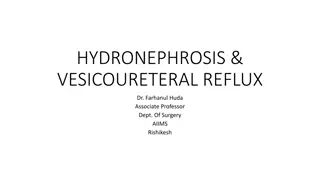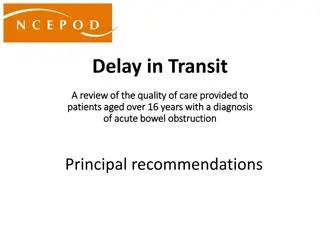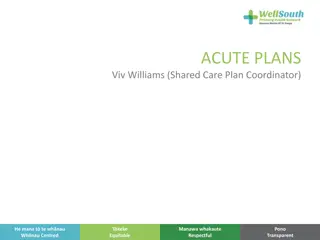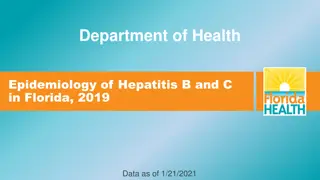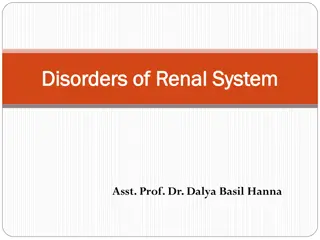Acute Pyelonephritis
Acute pyelonephritis is a serious bacterial infection affecting the kidneys, characterized by renal scarring, abscess formation, and sepsis. This article covers the definition, risk factors such as stones and surgery, etiology involving uropathogenic E. coli, and management strategies. Understand the signs, symptoms, and potential complications of this condition to guide diagnosis and prevention effectively.
Download Presentation

Please find below an Image/Link to download the presentation.
The content on the website is provided AS IS for your information and personal use only. It may not be sold, licensed, or shared on other websites without obtaining consent from the author.If you encounter any issues during the download, it is possible that the publisher has removed the file from their server.
You are allowed to download the files provided on this website for personal or commercial use, subject to the condition that they are used lawfully. All files are the property of their respective owners.
The content on the website is provided AS IS for your information and personal use only. It may not be sold, licensed, or shared on other websites without obtaining consent from the author.
E N D
Presentation Transcript
Acute Pyelonephritis Editing File: Edi t i ng Fi l e: Color Index: - - - - - - Main Text Important Females slides Males slides Doctor s notes Extra notes
Objectives Introduction Define pyelonephritis List risk factors Discuss the etiology and pathogenesis, epidemiology Describe signs and symptoms. List potential complications, other syndrome Discuss the diagnosis, management and prevention
Introduction It is a very serious condition that can lead to renal scarring,nephric, perinephric abscess formation, sepsis. Clinical presentation is atypical in some patients. Update on the management. Prevalence of bacteriuria in different age groups M al e s s l i des
Definition It is Bacterial infection of the renal pelvis, tubules and interstitial tissue of one or both kidneys Renal p arenchym a: pyelonephritis Uret hra: uret hri t i s Renal p el vi s : p yel i t i s . Bl adder: cys t i t i s UTI Terminology i nfect i o n o f uri nary bl adder i n ho s t w/o ut underl yi ng renal o r neuro l o gi c di s eas e. Young Female Healthy Non- Pregnant that is Uncomplicated any thing other than that is Complicated Uncomplicated i nfect i o n i n s et t i ng o f underl yi ng s t ruct ural , m edi cal o r neuro l o gi c di s eas e. Complicated > 2 s ym p t o m at i c UTI s w/i n 12 m o s . fo l l o wi ng cl i ni cal res o l ut i o n o f each p revi o us UTI aft er t herap y. Recurrent with same Organism Recurrent Pat i ent s wi t h t wo o r m o re s ym p t o m at i c UTI s wi t hi n 6 m o nt hs o r 3 o r m o re o ver a year. recurrent UTI caus ed by di fferent p at ho gen at any t i m e o r o ri gi nal i nfect i ng s t rai n >13 days aft er t herap y o f o ri gi nal UTI . Recurrent with Another Organism Reinfection recurrent UTI caus ed by s am e s p eci es caus i ng o ri gi nal UTI w/i n 2 weeks aft er t herap y. Relapse
Risk Factors 1-Stone 2-Surgery 3-Malignancy Pregnancy 1/2 o f as ym p t o m at i c wi l l devel o p p yel o nep hri t i s i f no t t reat ed Obstruction O bs t ruct i o n anywhere i n renal s ys t em , but t he m o s t co m m o n caus e o f i s renal s t o ne Diabetes 10 t i m es m o re adm i s s i o n Catheterized patients Immunosuppression Different explanation of UPEC in male and female slides. Enterobacterales: E.Coli Etiology Escherichia coli, whi ch acco unt s fo r 7 0- 90% o f unco m p l i cat ed UTI s and 21- 5 4 % o f co m p l i cat ed UTI s , A nd O t her Enterobacterals like the uropathogenic E. coli (UPEC) eri ves co m m o nl y fro m t he . p hyl o genet i c gro up s B2 and D, whi ch exp res s di s t i nct i ve O , K , and H ant i gens .UPEC genes enco de s everal p o s t ul at ed vi rul ence fact o rs ( VFs ) , i ncl udi ng adhes i ns P fim bri ae p ap +geno t yp e fam i l y, p ro t ect i ns , s i dero p ho res , and t o xi ns . Uro p at ho geni c E. co l i ( UPEC) : H ave enhanced p o t ent i al t o p ro duce UTI . UPEC genes enco de s everal vi rul ence fact o rs I ncl udi ng: Typ e 1 p i l l i , P p i l l i , A l p ha hem o l ys i n 1 Staphylococcus saprophyticus, Klebsiella pneumoniae, Proteus mirabilis, enterococci, Staphylococcus aureus, Pseudomonas aeruginosa, and Enterobacter s p eci es . 2 3 Rare candida, viruses, brucella, TB and Host factors
Pathogenesis Hematogenous spread to kidney is rare Ascending bacterial infection Exception: neonates with S.aureus 2 1 3 4 For optimal host defense function, intermittent & complete emptying of bladder must occur: Uri ne i s excel l ent cul t ure m edi um Bact eri ci dal s ecret i o n fro m uro ep i t hel i al cel l s and gl yco p ro t ei ns i nhi bi t bact eri al adherence Renal parenchyma infections res ul t i n i nflam m at o ry res p o ns e t o co nt ai n i nfect i o n but co nt ri but es t o p o t ent i al s carri ng Pathology Result in destruction of tubules and glomeruli Interstitial infiltration of inflammatory cells 1 2 4 3 5 Abscesses on the capsule and at corticomedullary junction Kidneys Enlarge When chronic: Kidneys become scarred, contracted, and nonfunctioning Can lead to Necrosis or got healed and formation of scar
Signs and symptoms Here we can differentiate between cystitis and Pyelonephritis -both of them has urgency,frequency and dysuria -but here in pyelonephritis we have Flank pain and Tenderness more In acute pyelonephritis Unilateral or bilateral 3 Flank pain (pain in the costovertebral angle) 1 2 Tenderness Important Lower urinary tract symptoms (urgency, frequency and dysuria) 6 Azotemia 4 5 Fever & Chill In chronic phase uncommon to occur -Unremarkable symptoms such as: (nausea and general malaise) -Systemic signs such as: (elevated BP, vomiting, diarrhea) 7 Other non infectious causes of these symptoms is renal infarct and caliculi Differential Diagnosis One fifth of the patients Acute pelvic inflammatory disease Diverticulitis 1 3 2 4 Ectopic pregnancy Renal calculi
Complications Hypertension, septic shock, multi organs failure, death rare Renal or prinephric abscesses Metastatic infection Papillary necrosis Localized/generalized atrophy OR permanent loss of function Acute renal failure Renal gangrene Emphysematous pyelonephritis Dr note: from439 Mainly complications related to the kidney and kidney injury Potentially complications related to BP, septic shock, and spreading to other areas. If the result was lower than the number below most likely it is normal flora , Also focus the number is the same but one in Liter and the other Milliliter. Diagnosis 8 5 Urinalysis and microscopy: bacteria (10/L or 10/ml) and pus >= 10/HPF (90%)and leukocytes esterase , RBCS 20-40% in the urine and leukocytosis. 1 A clean-catch or catheterized quantitative urine culture on BAP and selective media and sensitivity identifies the pathogen And determines appropriate antimicrobial therapy. 2 -Ultrasound or CT scan -IVP will Identify the presence of obstruction or degenerative changes caused by the infection process. -Blood culture 15-30% 3 4 BUN and Creatinine levels of the blood and urine may be used to monitor kidney function.
Management Mild sign and symptoms Severe cases Treated on an outpatient basis with antibiotics for 7-14 days Hospitalization Empirical treatment is TMP-SMX (Resistance around 50%), fluoroquinolones (ciprofloxacin) is alternative. Aminoglycoside (gentamicin) with or without ampicillin or third generation cephalosporins (ceftriaxone). Pipracillin/tazobactam or carbapenems in severe cases with risk of resistant bacteria. Antibiotics are selected according to results of urinalysis culture and sensitivity and may include broad-spectrum medications. Prevention Prognosis dependent upon early detection and successful treatment. Baseline assessment for every patient must include urinary assessment because pyelonephritis may occur as a primary or secondary disorder. Antimicrobial prophylaxis. TMP-SMX 3/week or nitrofurantoin daily. Intravaginal estradiol. 300 ml of Cranberry juice (Proanthocyanidins are a type of polyphenol compound). Removal of the urinary catheter as soon as possible or use condom catheter.
Pyelonephritis Introduction I t i s a very s eri o us co ndi t i o n t hat can l ead t o renal s carri ng, nep hri c , p eri nep hri c abs ces s fo rm at i o n, s ep s i s . Definition I t i s Bact eri al i nfect i o n o f t he renal p el vi s , t ubul es and i nt ers t i t i al t i s s ue o f o ne o r bo t h ki dneys i nfect i o n o f uri nary bl adderi n ho s t w/o ut underl yi ng renal o r neuro l o gi c di s eas e. Uncomplicated UTI Terminology i nfect i o n i n s et t i ng o f under l yi ng s t ruct ural , m edi cal o r neuro l o gi c di s eas e. complicated (Urinary tract infection) > 2 s ym p t o m at i c UTI s w/i n 12 m o s . fo l l o wi ng cl i ni cal res o l ut i o n o f each p revi o us UTI aft er t herap y Recurrent recurrent UTI caus ed by di fferent p at ho gen at any t i m e o r o ri gi nal i nfect i ng s t rai n >13 days aft er t herap y o f o ri gi nal UTI . Reinfection recurrent UTI caus ed by s am e s p eci es caus i ng o ri gi nal UTI w/i n 2 weeks aft er t herap y. Relapse Enterobacterales : E.Coli Staph.Aurues , Pseudomonas , Enterococci Rare Group: Etiology Candida , Viruses , Brucella Ascending Bacterial infection Pathogenesis Abscesseson the capsule and at Cortico-Medullary Junction Pathology 1- May be unilateral or Bilateral 2-Flank Pain (CostoVertebral junction) 3-fever 4-Azotemia 5- Renal infarct or Caliculi Signs & Systemic Signs Can occur as a result of the Chronic Disease: - Elevated Blood Pressure -Vomiting - Diarrhea Symptoms Septic Shock, Death Complications Urinalysis Quantitative urine culture -Ultrasound or CT scan Blood culture 15-30% - Diagnosis Diverticulitis Acute pelvic inflammatory disease Renal calculi Ectopic pregnancy Differential Diagnosis It is Better to look at the Previous Slide Management Pregnancy Diabetes Catheterized Patients Obstruction Immunosupp ression Risk Factors AntiMicrobial Prophylaxis Prevention dependent upon early detection and successful treatment. Prognosis
6-A 5-C MCQs 4-D 3-C 2-A 1-B 1- A 20-year-old male came to the hospital with flank pain, fever and azotemia. The diagnosis is: C-Chronic renal failure A-cystitis B-pyelonephritis D-Glomerulonephritis 2-A 6-year-old boy was brought to the emergency with abdominal pain and dysuria, urinalysis showed (increased number of WBCs) microbiological studies has shown lactose fermenter gram negative bacillus, what is the most likely organism? D- p s eudo m o nas aerugi no s a A - E. co l i B- S . ep i derm i di s C- Pro t eus vul gari s 3-recurrent UTI caused by same species causing original UTI w/in 2 weeks after therapy. A-Uncomplicated B-Complicated C-Relapse D-Reinfection 4- Which of the following is an important diagnosis method of pyelonephritis? A- Supra-pubic aspiration C- Elevated urea levels B- MRI D- Blood culture 5- What is the major symptom that differentiate between pyelonephritis and cystitis? A- Urgency B- Frequency C- Fever D- Dysuria 6- Which of the following does not contribute to prevent pyelonephritis? A- Wiping from back to front C-Removal of catheter D- Antimicrobial therapy B- Cranberry juice For more questions click here!
Cases/SAQ Q1: A diabetic patient came to the clinic complaining of flank pain, fever. 1-What is the diagnosis? 2-Give 2 investigation help to diagnose. Q2: How to manage patients with pyelonephritis? Answers Key Q2- If the symptoms mild we treated on an outpatient with antibiotics for 7-14 days like:ciprofloxacin and gentamicin If the symptoms sever, hospitalization, with pipracillin in case of risk of bacterial resistance. Q1 1-pyelonephritis 2-ultrasound, urinalysis
Microbiology Team442 Leaders Deema Aljuribah Mohammed Alghamdi Members Fatima Halawi Shahed Bukhari Layan Alburikan Amani Alotaibi Ahmad bahmaid Salman Albadr Hazem Almalki Yazeed Hussien Meshari Alshathri Ali Dhafer Shahad Almarshad Shaden Alamri Microbiology442@gmail.com
